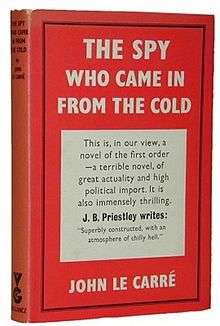The Spy Who Came in from the Cold
|
Cover for the Victor Gollancz first edition | |
| Author | John le Carré |
|---|---|
| Country | United Kingdom |
| Language | English |
| Series | George Smiley |
| Genre | Spy novel |
| Published | September 1963 Victor Gollancz & Pan |
| Media type | Print (hardback & paperback) |
| Pages |
256 pages (Hardback edition) & 240 pages (Paperback edition) |
| ISBN |
0-575-00149-6 (Hardback edition) & ISBN 0-330-20107-7 (Paperback edition) |
| Preceded by | A Murder of Quality |
| Followed by | The Looking-Glass War |
The Spy Who Came in from the Cold is a 1963 Cold War spy novel by British author John le Carré. It has become famous for its portrayal of Western espionage methods as morally inconsistent with Western democracy and values. The novel received critical acclaim at the time of its publication and became an international best-seller; it was selected as one of the All-Time 100 Novels by Time magazine.[1]
In 1965, Martin Ritt directed the cinematic adaptation The Spy Who Came in from the Cold, with Richard Burton as Alec Leamas.
Background
The Spy Who Came in from the Cold occurs during the heightened-alert politico-military tensions that characterised the late 1950s and early 1960s of the Cold War, when a Warsaw Pact–NATO war in Europe (Germany) seemed likely. The story begins and concludes in East Germany, about a year after the completion of the Berlin Wall and around the time when double-agent Heinz Felfe was exposed and tried.[2]
In Call for the Dead, le Carré's debut novel, a key character is Hans-Dieter Mundt, an assassin of the Abteilung ("the Department"), the East German Secret Service, who is working under diplomatic cover in London. When uncovered by agents George Smiley and Peter Guillam of the British intelligence service "the Circus" led by "Control", he escapes from England to East Germany before Smiley and Guillam can catch him. Two years later, at the time of The Spy Who Came in from the Cold, Mundt has risen from the field to the upper-echelon of the Abteilung, because of his successful counter-intelligence operations against the spy networks of the British secret services.
Plot
The West Berlin office of the Circus, under the command of Station Head Alec Leamas, has just lost its last and best double agent, shot whilst defecting from East Berlin. With no operatives left, Leamas is recalled to London by Control, the Circus chief, who asks Leamas to stay "in the cold" for one last mission: to fake the defection of a senior British agent to an East German operative named Mundt, and then to frame him as a British double agent. Fiedler, one of Mundt's subordinates — who suspects that Mundt is already a double agent — is targeted as a potentially useful adjunct.
To bring Leamas to the East Germans' attention as a potential defector, the Circus sacks him, leaving him with only a small pension. He takes and loses a miserable job in a run-down library. There, he meets Liz Gold, who is the secretary of her local cell of the Communist Party of Great Britain, and they become lovers. Before taking the "final plunge" into Control's scheme, Leamas makes Liz promise not to look for him, no matter what she hears. Then, after getting Control to agree to leave Liz alone, Leamas initiates the mission by assaulting a local grocer in order to get himself arrested.
After his release from jail he is approached by an East German recruiter and taken abroad, first to the Netherlands, then to East Germany, en route meeting progressively higher echelons of the Abteilung, the East German intelligence service. During his debriefing he drops casual hints about British payments to a double agent in the Abteilung. Meanwhile, Smiley, posing as a friend of Leamas, appears at Liz's apartment to question her about him and to offer financial help.
In East Germany, Leamas meets Fiedler. The two men engage in extended discussions, in which Leamas's pragmatism is contrasted with Fiedler's idealistic outlook. Leamas observes that the young, brilliant Fiedler is concerned about the rightness of his motivation and the morality of his actions. Mundt, on the other hand, is a brutal, opportunistic mercenary, an ex-Nazi who joined the Communists after the war out of expediency, and who remains an anti-Semite. Leamas decides to help Fiedler destroy Mundt.
The power struggle within the Abteilung is exposed when Mundt orders Fiedler and Leamas arrested and tortured. The leaders of the East German régime intervene after learning that Fiedler applied for an arrest warrant for Mundt that same day. Fiedler and Mundt are released, then summoned to present their cases to a tribunal convened in camera. At the trial, Leamas documents a series of secret bank account payments that Fiedler has matched to the movements of Mundt while Fiedler presents other evidence implicating Mundt as a British agent.
Meanwhile Liz, who had been invited to East Germany for a Communist Party information exchange, is called by Mundt's attorney as a witness. She admits that Smiley paid her apartment lease after visiting her, and that she promised Leamas to not look for him when he disappeared. She also admits that he had said good-bye to her the night before he assaulted the grocer. Realizing that their cover is blown, Leamas offers to tell all in exchange for Liz's freedom, admitting that Control gave him the mission to frame Mundt as a double agent. But when the tribunal halts the trial and arrests Fiedler, Leamas finally understands the true nature of Control and Smiley's scheme.
Liz is confined to a jail cell, but Mundt releases her and puts her in a car that will take her to freedom; Leamas is at the wheel. During their drive to Berlin, Leamas explains everything: Mundt is, in fact, a double agent reporting to Smiley. The target of Leamas's mission was Fiedler, not Mundt, because Fiedler was close to exposing Mundt. Leamas and Liz unwittingly provided Mundt with the means of discrediting Leamas, and in turn, Fiedler. Their intimate relationship facilitated the plan. Liz realizes to her horror that their actions have enabled the Circus to protect their asset, the despicable Mundt, at the expense of the thoughtful and idealistic Fiedler. Liz asks what will become of Fiedler; Leamas replies that he will most likely be executed.
Liz's love for Leamas overcomes her moral disgust, and she accompanies Leamas to a break in the wire fronting the Berlin Wall, from which they can climb the wall and escape to West Berlin. Leamas climbs to the top but, as he reaches down to help Liz, they are caught in the spotlights of the East German border guards. Liz is shot and falls while Leamas hesitates. Then he climbs back down the Eastern side of the wall, to be shot and killed too.
Cultural impact
At its publication during the Cold War (1945–91), the moral presentation of The Spy Who Came in from the Cold (1963) rendered it a revolutionary espionage novel by showing the intelligence services of both the Eastern and Western nations as engaging in the same expedient amorality in the name of national security. John le Carré also presented his western spy as a morally burnt-out case.
The espionage world of Alec Leamas portrays love as a three-dimensional, problematic emotion that can have disastrous consequences for those involved. Moreover, good does not always vanquish evil in Leamas's world,[3] a defeatist attitude that was criticized in The Times.[4]
In her essay Is Common Human Decency a Scarce Commodity in Popular Literature?, Margaret Compton contrasts the ending of The Spy Who Came in from the Cold with the ending of Call for the Dead: "Le Carré's début book ends with [George] Smiley feeling deeply guilty about having killed Dieter Frey, the idealistic East German spy who had been Smiley's agent and friend during the Second World War. Leamas and Liz, in the The Spy Who Came in from the Cold both make a diametrically opposite moral choice in that each values their personal relationship over any political loyalty."
Time magazine, while including The Spy Who Came in from the Cold in its top 100 novels list,[1] stated that the novel was "a sad, sympathetic portrait of a man who has lived by lies and subterfuge for so long, he's forgotten how to tell the truth."[5] The book also headed the Publishers Weekly's list of 15 top spy novels in 2006.[6]
Characters
- Alec Leamas: A British field agent in charge of East German espionage.
- Hans-Dieter Mundt: Leader of the East German Secret Service, the Abteilung.
- Fiedler: East German spy, and Mundt's deputy.
- Liz Gold: English librarian and member of the Communist Party.
- Control: Head of The Circus
- George Smiley: British spy, supposedly retired.
- Peter Guillam: British spy.
- Karl Riemeck: East German bureaucrat turned British spy
Awards and nominations
Le Carré's book won a 1963 Gold Dagger award from the Crime Writers' Association for "Best Crime Novel". Two years later the US edition was awarded the Edgar Award from the Mystery Writers of America for "Best Mystery Novel". It was the first work to win the award for "Best Novel" from both mystery writing organisations. Screenwriters Paul Dehn and Guy Trosper, who adapted the book for the 1965 movie, received an Edgar the following year for "Best Motion Picture Screenplay" for an American movie.
In 2005, the fiftieth anniversary of the Dagger Awards, The Spy Who Came in from the Cold was awarded the "Dagger of Daggers," a one-time award given to the Golden Dagger winner regarded as the stand-out among all fifty winners over the history of the Crime Writers' Association.
Footnotes
- 1 2 "All Time 100 Novels". Time. 16 October 2005. Retrieved 25 May 2010.
- ↑ Norman J. W. Goda. "CIA files relating to Heinz Felfe, SS officer and KGB spy" (PDF). Retrieved 2014-04-26.
- ↑ See, e.g., Barley, Tony. Taking Sides: The Fiction of John le Carré. Open University Press, 1986, p. 22.
- ↑ The Times, 13 September 1968.
- ↑ Grossman, Lev. All-TIME 100 Novels, TIME Magazine, 2005. Retrieved 29 October 2007.
- ↑ "Publishers Weekly list". top 15 spy novels.
External links
- Le Carré describes how he came to write the book (in an article published in The Guardian newspaper (April 2013) on the novel's 50th anniversary): "After a decade in the intelligence service, John le Carré's political disgust and personal confusion 'exploded' in The Spy Who Came in from the Cold."
- ↑ "Telecamera Spia". Retrieved Saturday, 29 October 2016

